All art is created within cultural perspectives and frameworks of expression. Given this inherent limitation, the most universal art is the least contained by references to the worldview of any particular group or sub-group. The cross-cultural potential is greatest for art forms that are visual [plastic, graphic and kinetic] and then aural [musical or verbal] – in that order. Language based art forms are the most culturally circumscribed.
The ultimate task in poetry/ritual/art/religion is to express in the simplest possible terms the human challenge in living a meaningful life. There are many subdivisions which can be explored within this larger challenge [relationship – friendship, romantic love, hatred, revenge; loss – death, injury, theft, catastrophe; power – leadership, conquest, greed, enslavement; etc.], but it is easy to become consumed in these domains and to lose sight of the paramount task of illuminating life as a whole.
When art becomes arduous to learn, or to produce, or to understand, we focus excessive attention on admiring the artistic envelope and tend to diminish the significance of the core message that the envelop contains. A major error we make in the more “advanced” cultures is to celebrate envelopes and artists and to make art self-conscious and self-referential. The best artistic envelopes are transparent and unencumbered by intellectual complication and allusion, or by identification with particular artists. Scholars and artists who celebrate the complication of art and publics who celebrate artists as much or more than art itself have lost sight of the core of the creative/humanistic process and the experiential purpose of art. In an enlightened world, all persons are artists and the value of art is located in the rewards of participating in the creative process rather than in the artistic product. We make a huge mistake when we give over the production of art to a few, celebrate these few as somehow special, and relegate the experience of the “rest” of the public to second class vicarious involvement. Eventually this mistake leads to the hideous notion of “owning” art – the mausoleum state for art. Ironically, our art museums actively participate in preserving art by promoting its dead state as “honored” physical product. We need to learn the lesson of sand painting. Art is an everyday means, temporary in nature, and not an end in itself. Most “Simple” cultures understand this. That is why art and ritual are fused in most of these cultures, and why art is the art of the ritual moment in which many participate as the creators, where this art is allowed to survive only as a reference to this valued ritual involvement, and where this art is not intended to be valued otherwise as important in itself.
The simplest artistic expression which captures an essential human truth will also be the most elegant – as in mathematical proofs. If the elegant expression is revealingly metaphorical, symbolic or compressed, it becomes art in whatever genre.
The greatest art a) is the most universal in reference; b) addresses the essential meaning of human existence; c) is simple, elegant and revealingly metaphoric, symbolic and/or compressed in expression; d) invites participation by many in the creative process; e) is readily understood; and f) avoids celebrating the artist, related art and artists, and the aftermath product of the process of creation.
The Message in the “Art of Life”
Nothing is “new” in this piece, only a different way of expressing old ideas as they are “rediscovered.” The message is carried by one of the simplest and most universal metaphors for life – the flower. Plants, and especially flowers in their various forms and types, are symbolically associated with virtually all key times and events in the life cycle for cultures worldwide. When we focus on the specific flower, we discover constant motion and change including birth and death, but when we consider the flower in the context of the much larger cycle that surrounds it, everything regarding the flower is constant and remains the same. The perception and conception of Change or Stasis is all a function of in what scale we locate our perspective. The Change we “see” at a lesser scale disappears to become Stasis at a greater scale, where we discover other “things” changing.
So, in the “Art of Life” above I offer only a static image of a stylized lilly. If I could fully realize my intention in a kinetic color image, it would repeatedly unfold and fold in response to light and heat. We would see this flower opening and closing in a daily life frame until it goes to seed while other surrounding flowers bloom, then we would see this same flower slowly disappear as a separate entity as the perspective shifts to larger and larger scale until the field of flowers of which it is a part itself becomes but an undifferentiated color spot from high altitude. This is one visual symbol of life: simple and nearly universal and suggesting both the importance of perspective and scale and the relevance of change and stasis, in the search for meaning. Overlaying this kinetic visual flower symbol is the poetic use of the English language, a much more culturally specific form of art. I have used a set of ascending rhyming words to capture in the context of the unfolding and refolding flower the movement for Yo [or You] through the process of discovering the material poles of life [sow – birth] and death [mow – reap] with the desire to stop right there [Whoa], to the more subtle awareness of nurture [grow to hoe] with the slow release to accept the inevitable [Slow], to the enlightened position of Knowing [Know] as it relates to being in the Flow of Being [Flow] with the awareness, “So that’s how it is,” [So], to the broadening unification awareness, as in “Oh, I see,” [Oh], to the static condition of radiating the fullness of enlightenment [Glow], to the reentry or return awareness of the need to act or not [Go or No]. As the flower opens and closes and as life proceeds, these are the progressive challenges in developing awareness of both self and the world and in determining the relationship of being to doing. We begin by acting or doing and satisfying our physical needs in the physical world [sow – mow], we proceed to more subtle and conceptual levels of social awareness – nurture [hoe – grow], until we discover ourselves Knowing our place in the Flow of reality, at which point we have an Ah..Ha moment in the unification [Oh] of our material and spiritual aspects of self and the world, from which we advance to Glow in wisdom, and out of which we must decide either on returning with enlightened activity or on dwelling in the passive condition of enlightened Being. As I see it, this is the challenge of the human life course, advancing or not with each unfolding and folding opportunity. Some make it little beyond the pragmatic sowing and mowing and the first move to social nurture in hoeing and growing. Others make it to knowing and flowing but often have only dogmatic faith to direct their use of it. A few reach various stages of expanding enlightenment [Glow]. Some of these remain in the cloistered ascetic domain to Dwell in the expanded state [No]; others return with enlightenment to be Active in promoting advanced awareness and its implementation in human affairs [Go].
Personally as an existential, dynamic humanist, I favor the Go option, but I recognize the fundamental dilemma contained in the Go/No location in the development cycle. In my view, absolute awareness without any action is as irresponsible and unbalanced as absolute action without any awareness. The goal in life should be that action reflect an ever developing state of awareness. In this way we encourage action while we require that great humility, respect and caution inform it. We cannot avoid the dilemma of having to act short of an ideal state of awareness. We must take the risk and act, but we can do so with the proper restraint and sensitivity. It is the position of balance within this dilemma that we must idealize, not the extreme of all-knowing avoidance. In my perfect world, I would make a minister of both the monk and the miner!
The creation of art is part of discovering, displaying and doing in the ongoing process of personal development. So, in the spirit of this offering, “Go” with grace, and create your own artistic visions of life as you flow through the process.

